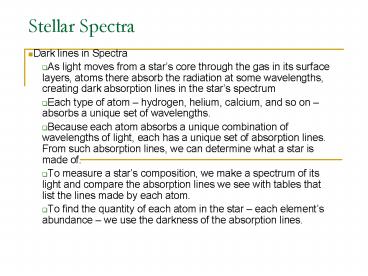Stellar Spectra PowerPoint PPT Presentation
1 / 12
Title: Stellar Spectra
1
Stellar Spectra
- Dark lines in Spectra
- As light moves from a stars core through the gas
in its surface layers, atoms there absorb the
radiation at some wavelengths, creating dark
absorption lines in the stars spectrum - Each type of atom hydrogen, helium, calcium,
and so on absorbs a unique set of wavelengths. - Because each atom absorbs a unique combination of
wavelengths of light, each has a unique set of
absorption lines. From such absorption lines, we
can determine what a star is made of. - To measure a stars composition, we make a
spectrum of its light and compare the absorption
lines we see with tables that list the lines made
by each atom. - To find the quantity of each atom in the star
each elements abundance we use the darkness of
the absorption lines.
2
Classification of Stellar Spectra
- 1866 Pietro Angelo Secchi
- Devised a system of classifying stars according
to color white, yellow, red, deep red - 1872 Henry Draper
- Recorded stellar spectra on photographs
- E.C. Pickering
- Used letters to subdivide Secchis classes.
- A-D for white, E-L for yellow, M-N for red
- 1901 Annie Jump Cannon
- Re-ordered the sequence according to temperature
- O, B, A, F, G, K, M, hottest-to-coolest
3
Definition of Spectral Classes
- Stellar spectral classes are based on the
appearance of the spectrum. - O-Type stars have weak absorption lines of
hydrogen, but strong absorption lines of helium. - A-Type stars have very strong absorption lines of
hydrogen. - F-type stars are distinguished by the multitude
of lines from metals such as calcium and iron. - G-type stars have weak hydrogen lines and strong
calcium lines. - K-Type stars are cooler and the hydrogen lines
are almost invisible. They do show lines of
numerous different carbon compounds. - M-Type stars are the coolest and show lines of
carbon compounds
4
Definition of Spectral Classes
- Temperatures of Spectral Classes
- O-type hotter than 25,000 K
- B-type 11,000 K 25,000 K
- A-type 7500 K 11,000 K
- F-type 6000 K 7500 K
- G-type 5000 K 6000 K
- K-type 3500 K 5000 K
- M-type 2200 K -3500 K
- Two recent additions
- L-type 1300 K 2200 K
- T-type 900 K 1300 K
5
Binary Stars
- Stars that orbit around each other
- Mutual gravitational attraction
- Astronomers can use binary stars to calculate
stellar masses. - Gravitational force between two bodies depends on
their masses - Gravitational force, in turn, determines the
stars orbital motion - If that motion can be measured, we can work
backwards to determine the masses
6
Eclipsing Binaries
- Binary stars that rotate on edge with respect to
the Earth. - One member of the binary passes between the other
member and Earth. - The duration of the eclipses depends on the
stars radii. - Astronomers can calculate the diameter of each
member of the binary.
7
H-R Diagram
- 1912 Working independently on separate sides of
the Atlantic Ocean, Ejnar Hertzsprung and Henry
Norris Russell found that if stars are plotted on
a diagram according to their luminosity and
temperature, then most of them lie along a smooth
curve. - Stars fall in the diagram along a diagonal line,
with hot luminous stars at the upper left and
cool dim stars at the lower right - Hertzsprung-Russell Diagram (H-R)
8
H-R Diagram
9
H-R Diagram
- By tradition, bright stars are at the top of the
diagram and dim stars at the bottom - Hot stars are to the left and cool stars are to
the right. - The approximately straight line along which the
majority of the stars lie is called the main
sequence.
10
H-R Diagram
- A stars luminosity depends on its surface area
and its temperature - If two stars have the same temp, any difference
in luminosity must reflect a difference in area. - A stars area depends on its radius large area
large radius - Stars that lie in the upper right of the diagram
have the same temperature as those on the lower
main sequence, but because they are more
luminous, they must be larger - These stars emit thousands of times more energy
than main sequence stars and therefore must be
immensely larger. - The region in the H-R diagram populated by giants
is sometimes called the giant branch - Because many of these stars are cool and
therefore red, they are called red giants.
11
H-R Diagram
- Stars lying below the main sequence must have
tiny radii if they are both hot and dim - Radii of these stars are typically 100 times
smaller than the Suns about the size of the
Earth - Because they are so hot they glow with a white
heat and are called white dwarfs.
12
H-R Diagram
- Giants and dwarfs differ dramatically in density
- Density is mass divided by volume
- For a given mass, a larger body will have a lower
density - If a giant star has a similar mass to a white
dwarf, its density will be much lower. - Luminosity classes
- A relationship between spectral line width and
luminosity - The width of the absorption lines in a stars
spectrum depends on its density. - The density of a star depends on its luminosity.
- Roman numerals are used for the luminosity
classes - Ia Supergiants (Brightest)
- Ib Dimmer Supergiants
- II Bright Giants
- III Ordinary Giants
- IV Subgiants
- V Main sequence (Dimmest)

